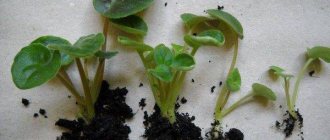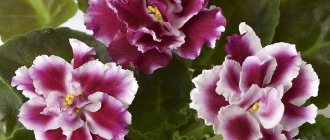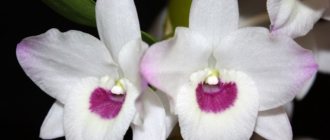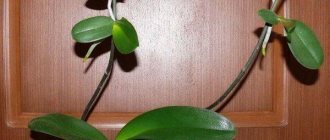An indoor flower with its appearance changes the entire atmosphere in the house. It is plants in pots that bring zest to the home and create a special charm.
Designers use many different plants specifically for this purpose, but orchids, and phalaenopsis in particular, are at the peak of popularity now.
You can also use artificial flowers for decoration, but a living stem will give you a special feeling, reward you for proper care with lush flowering and delight the eye with the lush green leaves.
Phalaenopsis is loved by gardeners because of
its exotic appearance and relative ease of care. There are many different varieties and types of indoor orchids, everyone chooses for themselves according to certain indicators.
The structure of orchid leaves
The orchid leaf is covered with a top layer - the skin (Epidermis), consisting of living cells.
The lower part covers the stem and forms the leaf axil. Protects the stem from damage. The base is usually thickened.
In orchids, leaves are most often located:
- alternately (one sheet is higher than the other);
- opposite (one sheet opposite the other).
The skin allows sunlight to reach the inner layers and protects the leaf from excessive moisture loss.
There may be hairs on the surface that protect against excessive overheating.
Depending on the place where orchids grow, the epidermis contains stomata from the bottom of the leaf and from both sides.
Stomata play an important role:
- evaporate water;
- regulate gas exchange;
- control the intensity of water evaporation;
- rate of photosynthesis.
The rate of evaporation depends on air humidity. The higher the humidity in the room, the less evaporation will occur.
When water evaporates, the orchid's temperature decreases and this protects the plant from overheating and regulates the flow of microelements from the roots to the leaves.
The faster evaporation occurs , the faster the process of photosynthesis .
An orchid can shed its leaves due to excessive loss of moisture in very dry climates. Also, together with them, it removes harmful breakdown products of substances that accumulate in the leaves.
In the upper layer of the epidermis there are tissue cells and intercellular spaces that are filled with air. The intercellular spaces are connected to the stomata and perform gas exchange and transpiration.
Cells store nutrients, sugar and starch. Vessels pass through the tissues - tubes through which substances formed during the process of photosynthesis flow.
The cells contain a large number of chloroplasts, in which the intensive process of photosynthesis occurs .
A sharp decrease in temperature from warm to cold leads to the destruction of chlorophyll . Therefore, the leaves may change their color.
As a rule, the drier the area where the crop grows, the denser the green mass, since it is this that maintains the level of moisture and nutrients.
The structure of the leaves and their location on the sunny side may differ from the location on the shady side.
Leaves growing on the sunny side are more elastic and dense. This is due to the fact that they need to withstand direct sunlight.
How to propagate?
In the greenhouse, the Sago orchid reproduces by seeds and sprouts that appear after flowering . And you can grow an orchid yourself with “babies” - small growths. It is better to propagate an orchid in late winter or early spring. The main condition is that this must be done after flowering.
First of all, you need to choose an adult orchid with good healthy roots and large leaves.- Using a sharp, clean, pre-treated knife, cut the top of the stem to the “dormant” bud, and the cut site is sprayed with charcoal or cinnamon for disinfection.
- We transplant the new shoot into a pre-prepared small pot with the necessary substrate.
- Pre-prepare the soil: a substrate of tree bark and moss is spilled with boiling water for 2 - 3 minutes to disinfect.
- Watering should be stopped for several days, the plant needs to recover.
Functions of leaves
In sympodial orchids, nutrients accumulate in bulbs (pseudobulbs), and for monopodial species, this role is played by leaves.
Functions of orchid leaves:
- photosynthesis;
- evaporation of water (transpiration);
- gas exchange;
- accumulation of nutrients.
The growth of leaves is limited to a certain size, unlike the roots and the stem itself.
The lifespan of leaves is different for each species. On average, leaves change from one to three per year. The old ones begin to turn yellow from the edges and gradually fade and dry out.
The dying process takes from one to several months.
Subvarieties and their photos
The Sogo orchid varieties are Yukidan and Vivien.
Yukidan
Yukidan flowers look like elegant figures - elongated, slender . The colors are delicate - white, pink, they grow up to 12-14 cm in diameter. The petals are round, widely spread, like sugar petals, and shimmer in good light. The lips are curly, small, and look like a brooch pattern against the background of a soft pink or white flower. The leaves are quite wide, monophonic, bright green in color, with a longitudinal vein in the middle, dense, glossy.
We recommend watching a video about the appearance features of the Sogo Yukidan orchid:
Vivien
Charming Asian beauty. The leaves are unusual, variegated, edged with a lighter color than the entire dark green, rich leaf. The leaves are dense, shiny, rounded. The flowers themselves are unusual, graceful, shimmering, as if sprinkled with shiny filling. Pink, with crimson veins, colorful and festive. Lips are bright, medium, curly. As this orchid grows it turns into a beautiful bouquet like Phalaenopsis multiflora .
We recommend watching a video about the appearance features of the Sogo Vivienne orchid:
What leaf color is abnormal?
The color of orchid leaves is green, the shade depends on the variety and living conditions of the plant, but green is always a healthy color.
- Yellowing indicates that the plant is withering or drying out. This may be due to improperly selected care. Also, too much fertilizer can cause yellowing of the leaves.
- Purple spots indicate that the orchid has been exposed to the sun for a long time and has received a sunburn.
- A red tint indicates that there is excessive lighting in the room.
- A brown color is a sure sign that the plant is infected with a disease.
- White or discolored areas with a brown outline indicate sunburn.
- Light areas that then begin to turn red may indicate the presence of a disease such as rust.
- Yellow rings and spots can indicate the presence of a viral disease.
Detailed description
Sogo orchid is a phalaenopsis with large flowers.
This hybrid is characterized by abundant flowering, a succession of flowers. A special type of flower stalks is very long, grows in a cascade, special supports are needed at home to ensure uniform growth of flowers and receive the same amount of light and heat. The leaves are large, oblong, grow up to 35-40 cm, dark green, dense, even harsh, as if covered with shine. Sogo orchids are distinguished by large, rich flowers covered with a shimmering spray; the color is the most varied: from white to light crimson, purple.
Variegation of orchid leaves
Variegated orchids are valued not only for their flowering, but also for the beauty of their leaves. While the orchid has bloomed, you can admire the unique pattern of the tops.
Variegation depends on the combination of different pigments in the cells; it can be more pronounced on young leaves under intense lighting. This color protects against burns.
Variability occurs for the following reasons:
- from natural mutation;
- in the process of artificial hybridization;
- due to the presence of genetically different types of cells in the same plant.
Pigmentation in cells may decrease in subsequent generations or remain completely. Depends on the type of cells.
Types of leaf variegation
The type of variegation depends on the type of pigmentation and its placement on the leaf.
1. Red or purple variegation
Red or purple variegation is not the result of a cell defect. The green pigment chlorophyll, which is involved in photosynthesis, is present, but is masked by carotenoids or anthocyanins. These same substances can give yellow and ocher colors.
The orchid copes well with the functions of photosynthesis; the chloroplasts are not damaged, but are protected from the aggressive environment with the help of pigments - carotenoids and/or anthocyanins.
IMPORTANT! Leaves with red or purple variegation are more sensitive to the damaging effects of direct sunlight. That's why nature protects them with pigments. Such leaves easily and quickly get sunburned.
Natural, natural red variegation is inherent in some phalaenopsis - Schiller, Stewart and others, as well as interspecific hybrids with their participation.
Phalaenopsis Schiller
The leaves of these species of phalaenopsis have specks , sometimes merging into transverse stripes.
Variegation in these phalaenopsis is more pronounced in more intense lighting and on young leaves (leaf color is simply protection of delicate leaves from the sun).
Many species and interspecific hybrids of Paphiopedilum have red (brown) and purple variegation.
2. Yellow and white variegation
Yellow and white variegation is the result of a defect or absence of chloroplasts, that is, plastids that contain chlorophyll. If the chloroplasts are damaged yellow variegation appears ; if there are no chloroplasts at all the leaf or part of it will turn white
Yellow and white variegation is a deviation from the norm; such orchids are weakened compared to their green relatives.
Types of variegation
1. Media variegation (central) – red, yellow or white. The color of the leaf changes in the center of the leaf.
2. Marginate (bordered) variegation - yellow or white coloring is located along the edges of the leaf.
3. Splash (uneven) variegation - yellow or white color is located randomly across the leaf, often in longitudinal stripes. Red or purple splash variegation occurs in Phalaenopsis and Paphiopedilum.
The brightness of the variegation depends:
- temperature conditions (at high temperatures, brightness increases);
- in bright light, the color of the leaves intensifies, since such species are more sensitive to light;
- during the period of active growth of young leaves, pigmentation increases;
- when using fertilizers with a high nitrogen content, the pigmentation is not so bright;
- with increased moisture-lovingness of the orchid in a dry climate, variegation may not appear or have weak signs, barely noticeable.
Features of keeping variegated orchids
Variegated orchids are more demanding in terms of living conditions. That is, leaf spotting may go away with age or is lost, and in bright rays the leaves are more susceptible to burns.
The only available tools to influence the brightness and severity of variegated areas:
- lighting level (diffused light 10-30 lux),
- temperature (20-25 degrees),
- air humidity (40-70%).
We cannot influence the quantity and quality of variegated segments in any way; it is impossible to control the appearance and activation of variegation in orchids at home.
Florist recommendations
Caring for various types of Vanilla orchids has some nuances that experienced gardeners willingly share:
- Vanilla flatifolia prefers heavy spraying to watering. It should be watered moderately, moistening the leaves several times a day.
- With hand pollination you can get pods of an expensive spice. The green fruit ripens after 7 months. Then it is processed in a certain way and used to flavor dishes.
- For irrigation, you can only use water that is completely free of lime. Otherwise, the roots will be damaged and the plant will begin to hurt. It is advisable to freeze the water and then defrost it. Before watering, the water is heated to +30…+35 degrees.
Advice! In order for the orchid to bloom, it is placed on the south window, but from 11:00 to 15:00 it is covered with a translucent protective screen.
Vanilla Orchid is an original plant with a pleasant aroma. But flowering of this variety can only be achieved under ideal conditions and with proper care technology.
Rate this post
Features of caring for a flowering plant at home
Phalaenopsis begins flowering at the age of 3 years. In rare cases - a year earlier. But this is not a reason for joy: the formation of buds takes away the strength of the plant, and it may die without forming a developed root system. In order not to harm the young orchid, it is better to cut off the peduncle that has formed ahead of time.
During flowering, the plant needs special maintenance and care:
- Stable air temperature without changes - 22-25 degrees.
- Humidity level not less than 60%. A decrease in the moisture content in the air during flowering is unacceptable. For the plant, this will be a signal of the onset of drought, and the flowers will drop.
- Regular moderate watering with warm water. It is undesirable to move phalaenopsis during the flowering period, so the substrate is moistened from a watering can directly into the pot.
- Bright lighting at least 12-14 hours a day. Since phalaenopsis flowering mainly occurs in the cold season, the natural length of the day is not enough. The lack of light is compensated by fluorescent or phytolamps.
Diseases and pests
- The spider mite reproduces very quickly, catching the entire orchid with a web. From this misfortune, flower growers are recommended to spray with a solution of phytoverma. At least 3 sessions are required with a break of 7 to 8 days.
- Various rot forms in the axils of the leaves, in the roots and on the peduncle if the air stagnates, the room is not ventilated, air circulation is disrupted, and the temperature drops. It is better to replant the orchid immediately, clean up the rotten roots, you must change the contaminated substrate, stop watering for a while. The roots are lubricated with foundation, and the “wound” is sprinkled with coal.
Tip : To treat pots and tools, you must use a copper sulfate solution.
We recommend watching a video about diseases and pests of orchids:
Active breeding work has led to the emergence of a huge number of species and varieties of orchids. Particularly popular among them are: Cattleya, Liodoro, Miltonia, Cambria, Philadelphia, Beauty, Manhattan, Lady's slipper, Wild cat and Oncidium.











